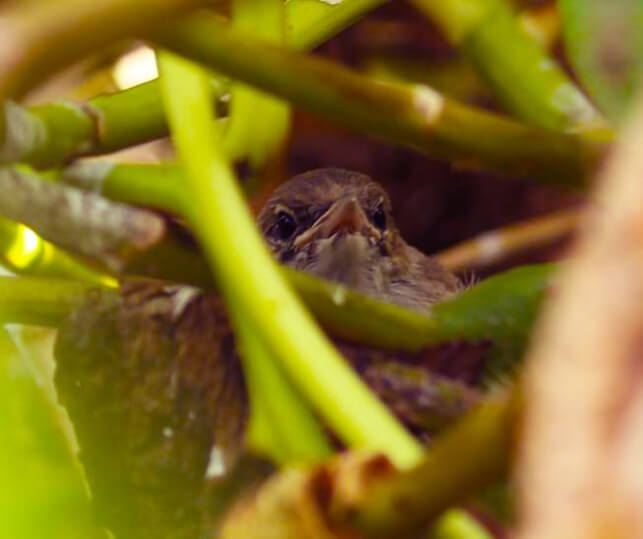Nearing Fifty Fledglings
July 1 – July 14, 2013
Megan Dalton and Andrea Kristof
Half the year is over, and the Millerbirds on Laysan have already had their most prolific year yet. Through our regular nest monitoring, we know that there have been at least 46 fledglings to date, easily surpassing last year's total of 29. While most of the birds are currently taking a break to molt, we expect them to begin another breeding wave sometime soon, with characteristic gusto.
As the fledglings become more independent, they begin to venture further and further into areas outside their natal territory. I imagine it is quite scary at first to navigate an unknown green sea of naupaka, with noisy seabirds in every bush and territorial adult Millerbird pairs scattered here and there. Perhaps that is why we often see the fledglings in small, loosely associated groups – to have some company with which to explore and embolden each other.
Michelle, the other member of the monitoring team, recently observed six different Millerbirds in a single shrub one morning. Two of these were adults feeding their recent fledgling and the rest were young birds that we had banded as nestlings a couple months ago. One of these started to beg and wing-flutter to the younger fledgling, which reciprocated in kind, starting off a prolonged counter-begging contest, bill lunge and chase around the bush. Just like kids on the playground, and maybe a storybook start to a pairing down the road?
Laysan Happenings
There has been a considerable increase in Laysan Duck breeding activity and encounters with humans over the last two weeks. A second wave of ducklings has emerged from along the east side of the lake, with a brood of ducklings even appearing in camp. Michelle also discovered a Laysan Duck nest while in search of a Millerbird nest in the northeastern naupaka vegetation. In addition, a recent explosion of the moth population in camp has enticed a female duck – Banded White Y – to post-up on the step to the kitchen tent gobbling up moths as they are flushed from crevices each time the door opens.
This past weekend we took an overnight camping trip to the northeastern desert, planning to star-gaze, watch Black-footed Albatrosses fledge, and enjoy a premium view of the sunrise. As the final sunlight disappeared, we were approached by three unlikely visitors. A flock of three Laysan Ducks very slowly (relative to the seabird avifauna with which they share the island) flew overhead and landed about twenty feet away from us. We were caught off-guard, as none of us had observed Laysan Ducks in the middle of the desert during the daylight hours, much less at night.
On Laysan, ducks are primarily found near the lake, but they are also consistently sighted at camp, on the hardpan sand (an area south of the lake that was intensively mined for guano in the 1800s that has yet to be revegetated), along the South Ledge (where waves crash over and create an intermittent stream), and occasionally, along the coast by tide pools. The three ducks instantly faced us and then meandered toward us in the side-winding fashion characteristic of curious Laysan Ducks.
It is amusing to think that, at that moment, all of us were probably thinking roughly the same thing – some derivative of “What the heck are they doing out here?” After a few minutes of this mutual investigation, the ducks turned around and began foraging in the local Nama sandwichensis, a small groundcover that occurs patchily in the desert. From their quick movements, we presumed that they were enjoying some sort of invertebrate dessert.
In albatross news, the “Great Abandonment” (of Laysan) has commenced. We find an increasing number of camp chicks traveling down to the shoreline in the morning hours to figure out how to fly. Many of them are still in the “flap really hard and jump” stage of learning, but a good number have discovered the importance of running while flapping those lengthy wings. Of particular note, two leucistic (i.e., reduced pigment) chicks – one Laysan Albatross in the North Desert and one Black-footed Albatross along the southern coast – have shed the majority of their down, appear in good health, and are well on their way to fledging. Megan also discovered a Black-footed chick in the Eastern Desert with unusual white patches of feathers surrounding its legs, nearly imitating the appearance of a pair of shorts.
Check back in two weeks when we will have more news from Laysan to share!
 Megan Dalton is a Millerbird
Megan Dalton is a Millerbird
monitoring biologist on Laysan.
 Andrea Kristof is a long-time Laysan camp manager and new member of the Millerbird team.
Andrea Kristof is a long-time Laysan camp manager and new member of the Millerbird team.




















































